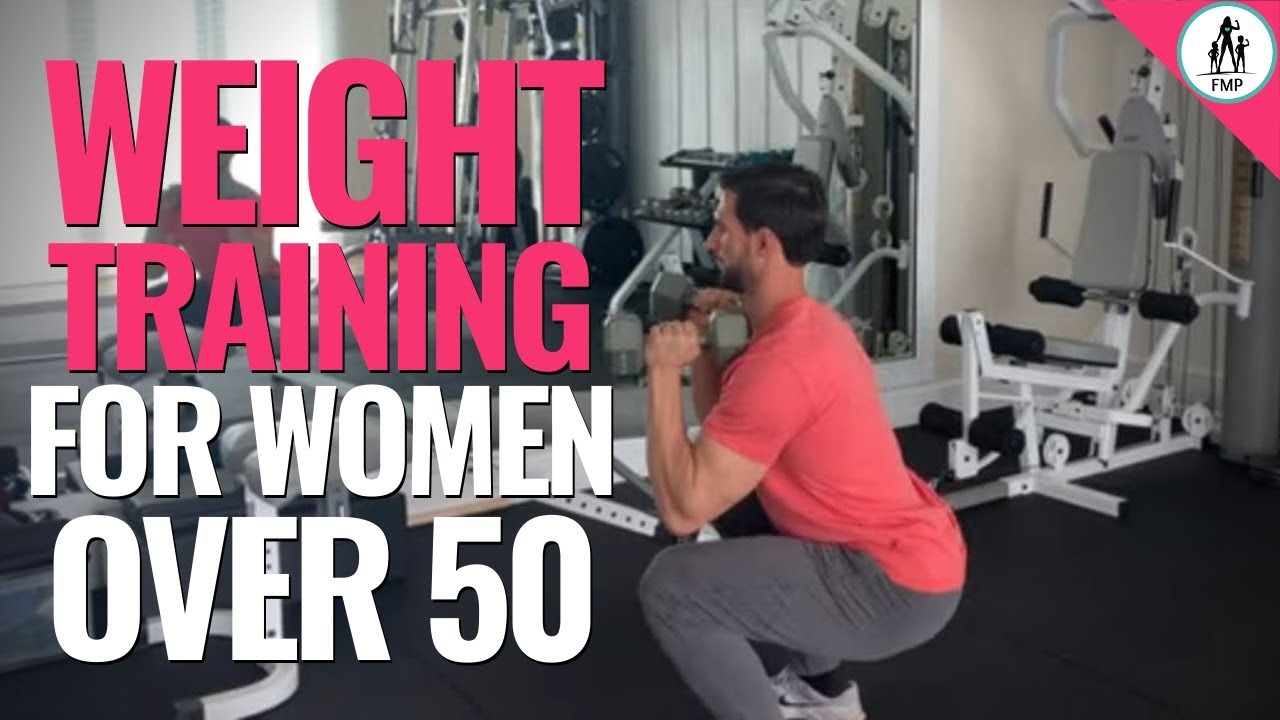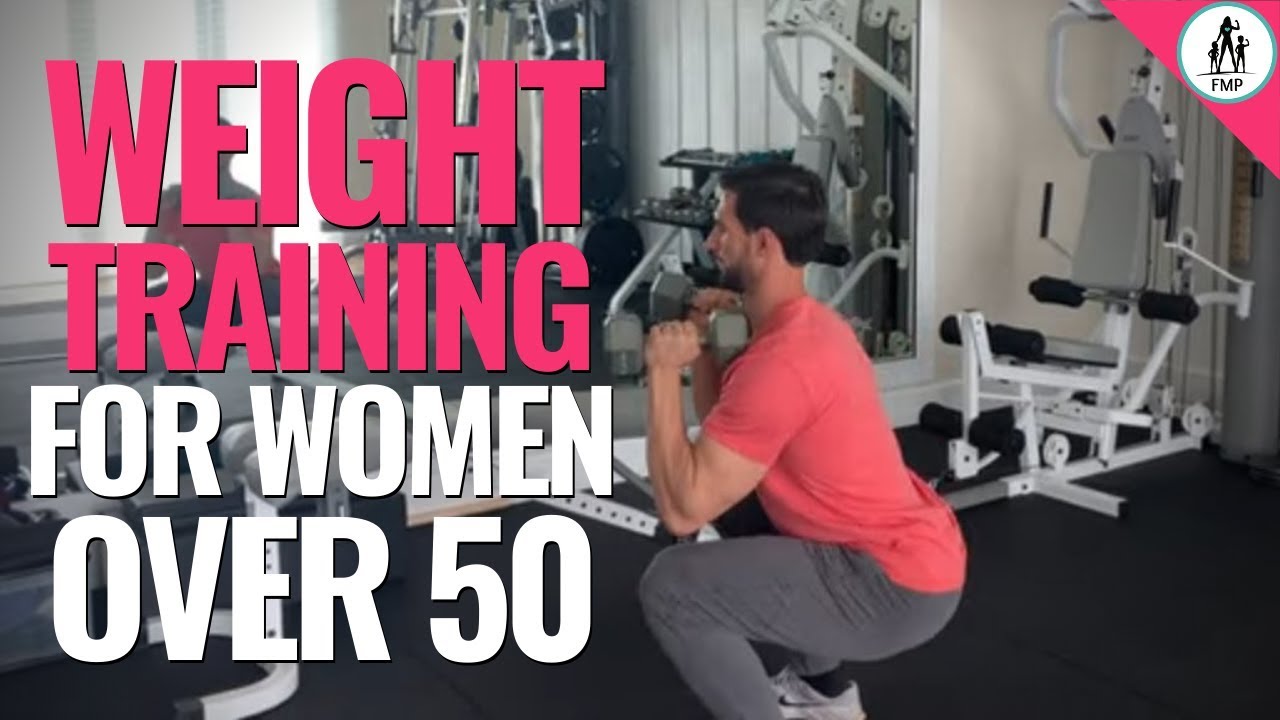Building muscle with strength training for women over 50? Think of it less as a grueling gym session and more as a superhero origin story! This isn’t about becoming a bodybuilder (unless you want to, go for it!), it’s about empowering your body, boosting your confidence, and feeling fantastic in your fabulous fifties and beyond. We’re talking stronger bones, better balance, increased energy – the kind of transformation that makes you say, “Wow, I feel amazing!” Get ready to discover the secrets to sculpting a stronger, healthier you, one lift at a time.
This guide dives deep into creating a safe and effective strength training program tailored specifically for women over 50. We’ll cover everything from choosing the right exercises and weights to fueling your body for optimal results. We’ll bust common myths, address concerns about joint pain, and provide practical tips to keep you motivated and injury-free. Prepare to unleash your inner strength!
Benefits of Strength Training for Women Over 50
Let’s face it, aging is inevitable, but feeling like a wobbly, brittle twig? Absolutely not! Strength training is your secret weapon to fight back against the effects of time and embrace a healthier, more vibrant you. This isn’t about becoming a bodybuilder (unless that’s your jam!), it’s about building a stronger, more resilient body that can handle life’s adventures – and maybe even a few extra slices of cake.
Bone Density Improvement in Postmenopausal Women
Postmenopause brings about a significant decrease in estrogen, a hormone crucial for maintaining bone density. This puts women at a higher risk of osteoporosis and fractures. But here’s the good news: strength training acts as a powerful countermeasure. The stress placed on bones during weight-bearing exercises stimulates bone growth, increasing density and reducing the risk of fractures.
Think of it as giving your bones a much-needed workout, making them stronger and more resistant to breakage. Studies have shown that women who consistently engage in strength training experience a significant increase in bone mineral density, leading to a lower risk of osteoporosis-related fractures.
Building muscle after 50? Think of it as a superpower you unlock! Forget frumpy – embrace fierce. Want to sculpt a body that defies gravity and whispers “youthful rebellion”? Then check out this killer strength training routine for weight loss and muscle building to get you started. It’s the secret weapon for women over 50 wanting to build muscle and feel amazing.
So ditch the rocking chair and embrace the iron – your future self will thank you!
Muscle Mass and Strength Gains
As we age, we naturally lose muscle mass, a process called sarcopenia. This leads to decreased strength, making everyday tasks more challenging. Strength training combats this decline by stimulating muscle protein synthesis, leading to increased muscle mass and strength. Imagine effortlessly lifting groceries, easily climbing stairs, and playing with your grandkids without feeling winded. That’s the power of strength training! Consistent training leads to noticeable improvements in strength and endurance, making everyday life easier and more enjoyable.
For example, a 55-year-old woman who started strength training reported being able to carry her own suitcase up the stairs without needing help after just three months.
Balance Improvement and Fall Prevention
Falls are a major concern for older adults, often leading to serious injuries. Strength training improves balance by strengthening the muscles responsible for maintaining posture and stability. It also enhances proprioception – your body’s awareness of its position in space. This combination significantly reduces the risk of falls. Think of it like this: stronger leg muscles and improved balance are like having an invisible safety net, keeping you steady on your feet.
A study published in the Journal of Aging and Physical Activity demonstrated that women over 50 who participated in a strength training program experienced a significant reduction in the number of falls they experienced compared to a control group.
Success Stories
Let’s hear from the champions! While I can’t share personal information due to privacy, countless women over 50 have transformed their lives through strength training. Many report increased energy levels, improved mood, reduced pain, and a newfound sense of confidence. One often-cited example is a woman who, after starting a strength training program, was able to hike a mountain she had previously deemed impossible.
Another woman regained her independence after strength training helped her overcome limitations caused by arthritis. These aren’t isolated cases; they’re testaments to the transformative power of strength training.
Comparison of Exercise Types for Women Over 50
| Exercise Type | Bone Health | Muscle Strength | Balance Improvement |
|---|---|---|---|
| Strength Training | Excellent: Stimulates bone growth | Excellent: Builds muscle mass and strength | Good: Improves stability and proprioception |
| Cardiovascular Exercise (e.g., walking, swimming) | Moderate: Improves overall health, indirectly benefits bone | Moderate: Improves cardiovascular fitness, but less muscle building | Moderate: Improves cardiovascular health, indirectly supports balance |
| Yoga/Pilates | Moderate: Improves posture and flexibility, indirectly supports bone health | Fair: Improves muscle tone, but less muscle building than strength training | Good: Enhances flexibility, balance, and body awareness |
| Tai Chi | Moderate: Improves balance and coordination, indirectly supports bone health | Fair: Improves muscle tone and flexibility | Excellent: Focuses on balance, coordination, and stability |
Getting Started
So, you’re ready to unleash your inner superheroine and sculpt a body that’s as strong as it is fabulous? Fantastic! But before you start hoisting weights like a seasoned Olympian (well, maybe notquite* yet), let’s lay a solid foundation for a safe and effective strength training journey. This isn’t about becoming a bodybuilder overnight; it’s about building a stronger, healthier you, one carefully planned rep at a time.Building a strength training program for women over 50 requires a thoughtful approach, focusing on proper form, gradual progression, and a healthy dose of self-awareness.
Remember, this is a marathon, not a sprint. Consistency and smart training are key to achieving long-term results and avoiding injuries.
A Sample Beginner Strength Training Program
This program is designed for women over 50 with no prior strength training experience. Remember to consult your doctor before starting any new exercise program.
Building muscle after 50? Forget those dusty gym memberships! You can totally sculpt those biceps (and triceps, and everything else!) with a fantastic at-home resistance training program using bodyweight exercises, like the one found here: at home resistance training program using bodyweight exercises. No more excuses, ladies – let’s get strong!
Warm-up (5-10 minutes):
- Light cardio, such as brisk walking or marching in place, to increase blood flow.
- Dynamic stretching, such as arm circles, leg swings, and torso twists, to prepare your muscles for activity.
Workout (20-30 minutes):
| Exercise | Sets | Reps | Rest |
|---|---|---|---|
| Chair squats | 2 | 10-12 | 30 seconds |
| Wall push-ups | 2 | 8-10 | 30 seconds |
| Bicep curls (using light weights or resistance bands) | 2 | 10-12 | 30 seconds |
| Triceps dips (using a chair) | 2 | 8-10 | 30 seconds |
| Overhead press (using light weights or resistance bands) | 2 | 10-12 | 30 seconds |
Cool-down (5-10 minutes):
- Static stretching, holding each stretch for 20-30 seconds. Focus on major muscle groups worked during the workout, such as quads, hamstrings, biceps, and triceps.
Proper Form and Technique
Proper form is paramount! Think of your body as a finely tuned machine; incorrect form is like throwing sand in the gears. It not only reduces the effectiveness of your workout but significantly increases your risk of injury. Start with lighter weights or resistance to master the correct technique before increasing the intensity. Consider working with a qualified personal trainer, especially when beginning, to ensure you’re using proper form.
Videos demonstrating correct exercise form can also be incredibly helpful. For example, a video demonstrating a proper squat would show the feet shoulder-width apart, the back straight, and the knees tracking over the toes. Improper form could lead to knee pain or back strain.
Common Mistakes and Solutions
Many women over 50 make common mistakes when starting strength training. For example, using weights that are too heavy too soon can lead to frustration and injury. A better approach is to start light, focus on form, and gradually increase weight as you get stronger. Another common mistake is neglecting rest days. Your muscles need time to recover and rebuild, so incorporate rest days into your schedule.
Choosing the Right Weights and Resistance
The “right” weight is the one that challenges you without compromising your form. You should feel exertion by the last few reps of each set, but not so much that you have to sacrifice good form. If you can easily complete all reps with perfect form, it’s time to increase the weight or resistance slightly. If you find yourself struggling to maintain good form, decrease the weight or resistance.
Listening to Your Body
This is crucial! Don’t push through pain. A little muscle soreness is normal, but sharp or persistent pain is a warning sign. Rest, modify the exercise, or stop altogether if you experience pain. Your body will tell you what it needs – pay attention! Remember, consistency is key, but so is listening to your body’s signals.
Building muscle with strength training after 50? Think of it as a superpower! It’s not just about looking great; it’s about feeling fantastic. If you’re new to this whole strength-training thing, check out this amazing program for weight loss beginners: Best strength training program for weight loss beginners – it’ll give you a solid foundation before you start sculpting those amazing biceps (and everything else!).
Then, you’ll be ready to conquer those weights like a boss, proving age is just a number!
Exercise Selection and Progression
Let’s face it, ladies – the fountain of youth isn’t a magical spring, it’s a well-crafted strength training program! Choosing the right exercises and progressing wisely is key to building muscle, boosting your metabolism, and feeling like a superheroine (even if your cape is just a comfy sweatshirt). This isn’t about becoming a bodybuilder; it’s about empowering your body and enjoying the process.
Selecting exercises and progressing gradually is crucial for building strength and avoiding injuries. It’s about finding a balance between challenging yourself and listening to your body. Remember, consistency is more important than intensity, especially as we age. Start slowly and build up gradually; Rome wasn’t built in a day, and neither is a rock-solid physique.
Effective Strength Training Exercises for Women Over 50
This list focuses on compound exercises, which work multiple muscle groups simultaneously, maximizing your time and results. Remember to consult your doctor before starting any new workout routine.
- Squats: Targets legs and glutes. Imagine sitting down in an invisible chair.
- Lunges: Works legs and glutes, improving balance and coordination.
- Push-ups (modified on knees if needed): Strengthens chest, shoulders, and triceps. Think powerful posture!
- Rows (using dumbbells or resistance bands): Builds upper back strength, improving posture and reducing back pain.
- Overhead press (dumbbells or resistance bands): Targets shoulders and triceps. Imagine lifting a heavy (but imaginary!) shopping bag.
Proper Form for Key Exercises
Correct form is paramount to prevent injuries and maximize results. Think quality over quantity!
- Squats: Stand with feet shoulder-width apart, lower your hips as if sitting in a chair, keeping your back straight and chest up. Push through your heels to return to standing.
- Lunges: Step forward with one leg, bending both knees to 90 degrees. Keep your front knee aligned with your ankle. Push off with your front foot to return to standing.
- Push-ups: Start in a plank position, lower your chest towards the floor, keeping your body in a straight line. Push back up to the starting position.
- Rows: Sit or stand with good posture, holding dumbbells or resistance bands. Pull the weights towards your chest, squeezing your shoulder blades together. Slowly lower the weights back to the starting position.
- Overhead press: Stand with feet shoulder-width apart, holding dumbbells or resistance bands at shoulder height. Press the weights overhead, keeping your core engaged. Slowly lower the weights back to the starting position.
Progression Plan for Increasing Weight and Resistance
Gradually increasing the weight or resistance is crucial for continued muscle growth. Don’t rush this process!
A good starting point is to choose a weight that allows you to complete 10-12 repetitions with good form. As you get stronger, you can increase the weight or resistance, aiming for 8-12 repetitions. Consider a progression plan like this:
- Weeks 1-4: Focus on mastering form and completing 10-12 repetitions with a manageable weight.
- Weeks 5-8: Increase the weight slightly, aiming for 8-12 repetitions. If you can easily complete 12 reps, increase the weight next session.
- Weeks 9-12: Continue increasing the weight or resistance as needed, always prioritizing good form.
Remember to listen to your body and adjust the plan as needed. Rest and recovery are just as important as the workouts themselves!
Incorporating Different Training Methods
Spice things up to avoid plateaus and keep your workouts exciting!
Building muscle after 50? Think of it as a superpower, ladies! Forget the myth of shrinking violets – strength training is your secret weapon. Need a program that fits your jam-packed schedule? Check out this amazing strength and muscle building program for busy professionals to help you sculpt those muscles. Then, get ready to unleash your inner Amazon warrior and conquer those age-related muscle losses!
- Circuit Training: Perform a series of exercises one after another with minimal rest, then repeat the circuit 2-3 times. This is a fantastic way to improve cardiovascular fitness while building strength.
- Supersets: Perform two exercises back-to-back with minimal rest, targeting opposing muscle groups (e.g., biceps curls followed by triceps extensions). This method is efficient and can boost muscle growth.
Bodyweight Exercises vs. Weights/Resistance Bands, Building muscle with strength training for women over 50
Both have their merits. It’s not an either/or situation!
| Bodyweight Exercises | Weights/Resistance Bands |
|---|---|
| Convenient, require no equipment | Allow for progressive overload, targeting specific muscle groups more effectively |
| Great for beginners, building a foundation | More challenging, leading to greater strength gains over time |
| Can be modified for different fitness levels | Offer a wider range of exercise options |
Many find a combination of both to be the most effective approach, using bodyweight exercises for warm-ups and certain movements, and weights or resistance bands for progressive overload.
Nutrition and Recovery: Building Muscle With Strength Training For Women Over 50

Fueling your fabulous fitness journey over 50 requires more than just lifting weights; it’s about nourishing your body to rebuild and strengthen those muscles. Think of it as giving your body the VIP treatment it deserves after a killer workout. We’re not talking about fad diets here, but a smart, sustainable approach to nutrition that supports your strength training goals and keeps you feeling your best.Adequate protein intake is crucial for muscle growth and repair, especially as we age.
Our bodies become less efficient at protein synthesis after 50, meaning we need to be more intentional about getting enough. This isn’t about becoming a protein-obsessed bodybuilder; it’s about ensuring your muscles have the building blocks they need to recover and grow stronger.
Building muscle after 50? Think of it as a superpower you unlock! It’s never too late to sculpt those biceps, and ditching the bingo wings is totally doable. To get started, check out these fantastic Effective weight lifting routines for women over 40 – they’re a great jumping-off point, even if you’re a few years older.
Remember, strong women lift heavy things; it’s science, not sorcery!
Protein Intake for Muscle Growth and Repair
Protein is the superhero of muscle building. It provides the amino acids that are the fundamental components of muscle tissue. For women over 50 engaging in strength training, aiming for 1.2 to 1.6 grams of protein per kilogram of body weight is generally recommended. This translates to roughly 75-100 grams of protein for a 60kg woman. Remember, consistency is key! Spreading your protein intake throughout the day is more effective than consuming it all in one go.
The Role of Nutrition in Supporting Strength Training Goals
Nutrition isn’t just about protein; it’s a holistic approach to fueling your workouts and recovery. Carbohydrates provide the energy for your strength training sessions, preventing fatigue and maximizing your performance. Healthy fats support hormone production and overall health, contributing to a balanced approach to fitness. Vitamins and minerals play essential roles in muscle function, bone health, and immune support, all crucial for a successful strength training program.
Ignoring nutrition is like trying to build a house with substandard materials – it simply won’t hold up.
Nutrient-Rich Foods Supporting Muscle Growth and Recovery
Prioritizing nutrient-dense foods is vital. Here’s a list of powerhouses to include in your diet:
- Lean protein sources: Chicken breast, fish (salmon, tuna), turkey, lean beef, eggs, Greek yogurt, lentils, beans.
- Complex carbohydrates: Brown rice, quinoa, sweet potatoes, oats, whole-grain bread.
- Healthy fats: Avocado, nuts (almonds, walnuts), seeds (chia, flax), olive oil.
- Fruits and vegetables: A rainbow of colors provides a wide array of vitamins, minerals, and antioxidants.
The Importance of Sleep and Rest for Muscle Recovery
Sleep isn’t just a luxury; it’s a fundamental pillar of muscle recovery and overall well-being. During sleep, your body repairs and rebuilds muscle tissue, and your hormones regulate. Aim for 7-9 hours of quality sleep per night. Think of sleep as your body’s nightly muscle-building workshop. Insufficient sleep hinders recovery, impacting your strength gains and overall health.
Sample Meal Plan for Muscle Building and Recovery
This is just a sample, adjust portions based on your individual needs and activity levels:
- Breakfast: Oatmeal with berries and nuts, Greek yogurt with fruit and a sprinkle of chia seeds.
- Lunch: Salad with grilled chicken or fish, quinoa, and a variety of vegetables.
- Dinner: Baked salmon with roasted sweet potatoes and broccoli.
- Snacks: Hard-boiled eggs, a handful of almonds, apple slices with peanut butter.
Addressing Common Concerns

Let’s face it, embarking on a new fitness journey, especially one as transformative as strength training, can feel a bit daunting. Concerns about aches, pains, and pre-existing conditions are completely understandable. This section aims to alleviate those worries and empower you to confidently take the first step (or lift the first weight!). We’ll tackle common anxieties head-on, providing you with the knowledge and strategies to navigate them successfully.
Joint Pain and Arthritis
Many women over 50 worry that strength training will exacerbate joint pain or arthritis. The good news is, the opposite is often true! Strength training, when done correctly, can actually
reduce* joint pain. Building stronger muscles surrounding the joints provides better support and stability, lessening the strain on the affected areas. Think of it like this
stronger muscles act as natural shock absorbers, cushioning your joints during daily activities. However, it’s crucial to choose exercises that are gentle on your joints and to use proper form. This means avoiding high-impact movements and focusing on controlled, deliberate repetitions. Listen to your body; if an exercise causes sharp pain, stop immediately and consult a healthcare professional.
Modifications for Women with Pre-existing Health Conditions
Having a pre-existing health condition doesn’t automatically disqualify you from the benefits of strength training. In fact, tailored programs can be incredibly beneficial. For example, a woman with osteoporosis might benefit from weight-bearing exercises to increase bone density, but would need to avoid high-impact activities. Someone with hypertension might need to adjust the intensity and duration of their workouts.
The key is to work with a qualified professional – a doctor or physical therapist – to create a personalized plan that accommodates your specific needs and limitations. They can help you modify exercises, choose appropriate weights, and monitor your progress safely.
Importance of Consulting a Doctor or Physical Therapist
Before starting any new exercise program, especially strength training, it’s essential to consult your doctor or a physical therapist. This isn’t just a precaution; it’s an investment in your safety and success. They can assess your overall health, identify any potential risks, and help you design a program that’s safe and effective for you. Think of it as getting a personalized roadmap to your fitness goals – a roadmap that prioritizes your well-being.
This consultation ensures you’re not just exercising, but exercising – smartly*.
Staying Motivated and Consistent
Consistency is key when it comes to strength training. Staying motivated can be challenging, but there are ways to make it easier. Find an exercise buddy for accountability and support; the shared commitment can make all the difference. Set realistic, achievable goals – small victories build momentum. Reward yourself for reaching milestones, not just with treats, but with things that truly nourish your soul: a relaxing bath, a new book, or a massage.
And remember to celebrate your progress; every rep counts!
Overcoming Barriers to Starting and Maintaining a Strength Training Routine
Life throws curveballs, and sometimes, sticking to a workout routine feels impossible. Lack of time is a common barrier; try incorporating short, effective workouts into your day, even just 10-15 minutes. Lack of access to a gym can be overcome with home workouts using bodyweight exercises or affordable resistance bands. Feeling intimidated by the gym environment can be addressed by starting with a personal trainer for a few sessions or finding online workout videos that cater to beginners.
Remember, starting is the hardest part; once you experience the positive effects of strength training, staying consistent becomes easier.
Final Wrap-Up

So, there you have it – your roadmap to a stronger, healthier, and more confident you! Building muscle after 50 isn’t just possible; it’s incredibly rewarding. Remember, consistency is key, and listening to your body is paramount. Don’t be afraid to start small, celebrate your progress, and embrace the journey. You’ve got this! Now go forth and conquer those weights (and maybe a few age-related stereotypes while you’re at it!).
